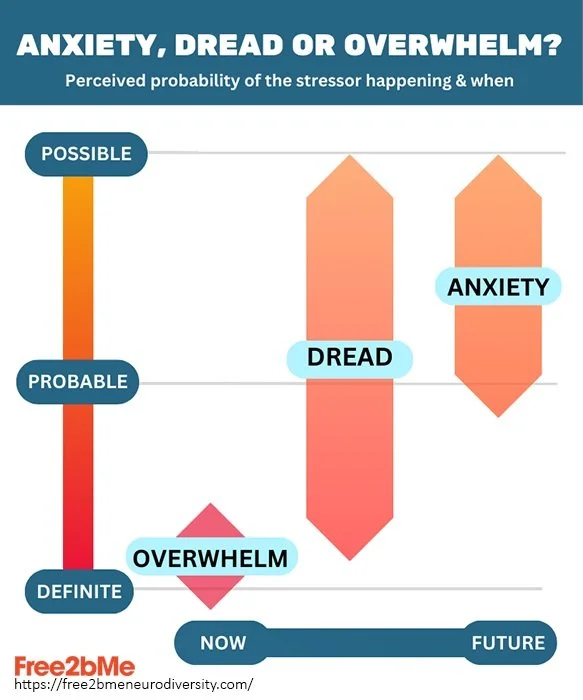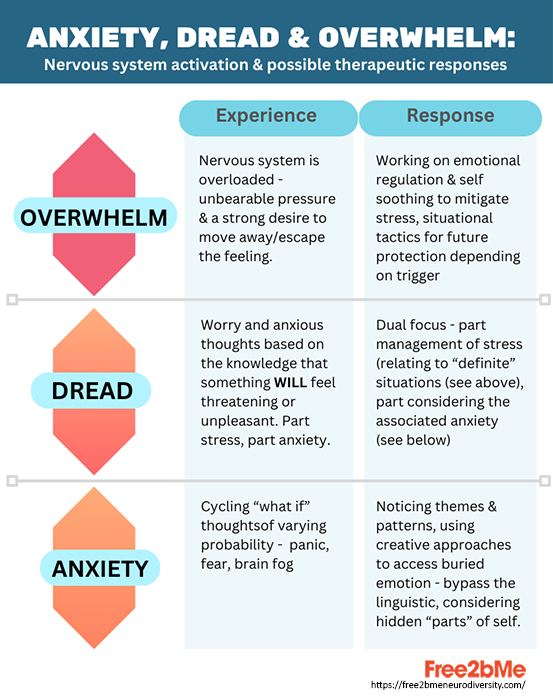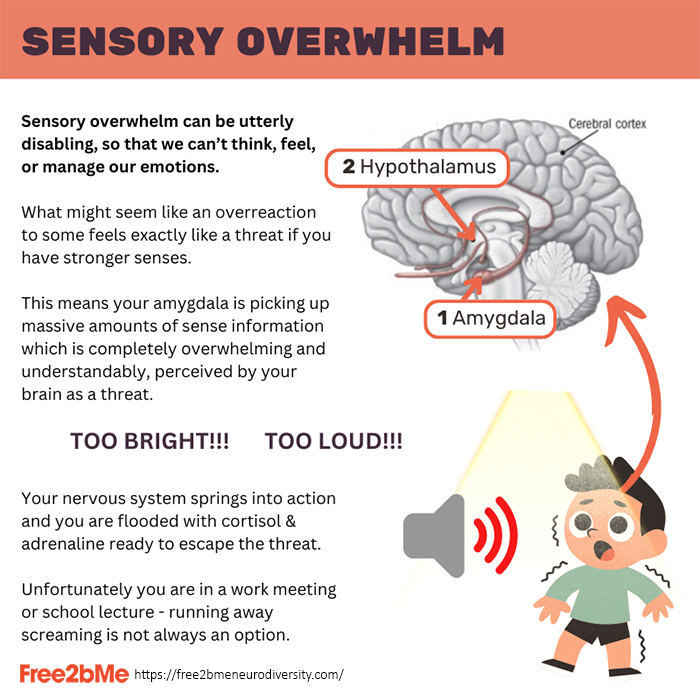Is it anxiety, dread or overwhelm? - exploring neurodivergent responses to threat
Feeling constantly anxious is not an unfamiliar experience for neurodivergent people, but when I ask clients to explore what that anxious feeling is, through emotional, experiential and contextual lenses, I see something far more complex and nuanced than the use of the word anxiety might indicate.
The neurotypical experience of anxiety is often described as future focused, a cyclical “what if?” assessment of anticipated future threats. When we talk about neurodivergent anxiety, it seems people are actually experiencing a number of different types of stressor: I’m going to group these under the headings Anxiety, Dread and Overwhelm.
Anxiety, Dread or Overwhelm?
For neurodivergent people, particularly those who are only just beginning their journey toward understanding their neurodivergent self, the word anxiety may feel pretty close to what they are experiencing. But often they will say that it doesn’t feel right.
Assuming that we are looking at anxiety in the way we (neuro)typically understand it, we may go down the wrong route in trying to support neurodivergent individuals. Noticing that the word anxiety doesn’t necessarily feel right to them is important if we are to differentiate between anxiety, dread and overwhelm in a neurodivergent context.
So that we can better understand what neurodivergent anxiety, dread and overwhelm might be, and develop the most appropriate strategies to support our neurodivergent clients, I’ve framed them in the context of timescale, likelihood and how they might be experienced by neurodivergent clients.
In fact, the experiences we might describe as anxiety, dread and overwhelm, are different variations of nervous system activation. What we are actually talking about is a combination of stress (reacting to threat) and anxiety (reacting to the possibility of stress), with differing levels of knowledge about what might happen.
The fact we use all of these words, relatively interchangeably, means we might struggle to understand what people are actually experiencing, and how we might help them to cope.
So what actually happens when we experience stress, anxiety and (sensory)overwhelm ?
In summary:
Stress is – a response to something happening now that is threatening to our safety.
Anxiety is – an anticipatory response to a potential threats or stressors.
Some examples of neurodivergent overwhelm, dread and anxiety
Overwhelm is… a threat response and can be viewed and therefore “treated” as stress.
Example: You are very sensitive to bright lights and loud sounds – you are trying to work under a very bright overhead light while someone uses a pneumatic drill just outside your window. You can’t concentrate, your heart is racing, you just want to leave the office. You snap at your colleague when they ask you a question. You feel completely incapacitated.
Dread is… an extreme form of anxiety where there is a very high or definite likehood of exposure to theats/stressors.
Example: You’ve been asked to go to a birthday meal in a very bright, noisy, chaotic restaurant. You don’t like the food they serve. You know there will be people their that make you feel judged and uncomfortable. You desperately find reasons not to go but feel obliged as it’s for a family member.
Anxiety is… well I’ve described my own experience of this as “background radiation – always there, always making me feel tense and jumpy”.
This can be a constant, persistent feeling that something is wrong, or something bad is going to happen. If considered from a neurodivergent perspective, this constant or regular anxious feeling is an understandable response.
Often neurodivergent people experience repeated negative and commonly traumatic reactions to their way of being. There is an argument for describing such experiences as CPTSD. However we describe them, we know that:
“Traumatic experiences can keep your brain hovering in survival mode, always on alert and anticipating” Healthline, 2024
Implications for therapy
All these roads – anxiety, dread and overwhelm – lead to nervous-system activation - the sympathetic nervous system (SNS) is activated and we are filled with adrenaline and cortisol.
Although stress and anxiety are natural ways we can avoid threatening situations, if they are very regular, as with sensory overwhelm, or if seem out of proportion to the likelihood or impact of the situation we are responding to, as with near constant anxiety, then we need to understand why we are reacting in that way and find ways to manage those responses.
And it’s important, in terms of our therapeutic responses, to notice the timeframe of the experience and to respond to current experiences by helping the client to prevent avoidable harm.
So our therapeutic responses might aim to:
Prevent harm – what protection is available when this person is under threat?
Increase choice & capacity to respond to or avoid actual threats
Explore the root of perceived threats, including abstract threats such as existential dread, symbolic threat, safety threat, cohesion threat, prejudice threat etc.
If we are talking about overwhelm, then we need tactics to avoid, manage or adapt to the situations that make us feel overwhelmed.
If we are talking about anxiety, then we need to be curious about why we are anxious, as well as how we might avoid, manage or adapt to the future situations that make us feel anxious.
If we are experiencing constant or persistent anxiety with no obvious cause or trigger, then we might want to explore how we experience the world so we can better manage our responses to it. This includes a consideration of the often fundamentally traumatic experience of being neurodivergent.
Near constant anxiety can cause all manner of stress-related health impacts - to mitigate these, we need to develop strategies to enable our parasympathetic nervous system (PNS) (the system that helps the body relax and recover from stressful situations) to do its job. This is where exploring self-care is essential, and where using flow-state creating activities may be beneficial, to support clients in reaching a nervous system equilibrium.
A note on the concept of adaptations
Often when we think about approaches to supporting neurodivergent people, we think about adaptations. I would suggest that adaptations is a useful word when thinking about how we might reduce threats experienced by neurodivergent people, for instance, at work. But when we consider therapeutic approaches, I feel we should be thinking more in terms of preventing harm.
For some neurodivergent people, constant loud noise is an actual threat. We usually respond to threats by moving away from them, or protecting ourselves against them. Noise cancelling headphones therefore become Personal Protective Equipment (PPE), rather than “adaptations”, a description I feel represents the level of harm a neurodivergent person may experience.
As Dr Neff says, autistic (and neurodivergent) anxiety is “intimately tied to the ways in which Autistic individuals process sensory information, social cues, and changes in their environment. Understanding these triggers is crucial for developing supportive strategies that address the unique needs of Autistic individuals”.
And a really important point when considering anxiety…
Our brains aren’t great at judging what’s real and what’s imagined
We need to keep in mind, that whether the threats we are responding to are actual or anticipated, OUR BRAINS THINK THEY ARE REAL.
Our threat response is a relatively basic system that allows us to bypass logical thought, so that we can respond quickly. But it is also open to error - we can get stuck in a feedback loop where the more we react to perceived threats by acting as if they are real, the more our brains consider those threats to be worthy of flight, fight, freeze or fawn.
And because our senses and emotions are the drivers for the amygdala to alert us to threat, which happens so fast our logical minds are bypassed, trying to logic our way out of anxiety is unlikely to work.
Effective therapy for anticipatory dread & persistent anxiety will therefore most likely be found in the realm of the limbic system – in our emotions and in our senses. Creative approaches to addressing anxiety, particularly those that bypass the linguistic, may therefore be more effective than approaches which rely more on the logical, thinking brain.
Want to know more? We have courses to help you
If you are interested in learning more about how you can support neurodivergent clients experiencing anxiety, dread or overwhelm, then take a look at our live courses:
Working therapeutically with adult ADHD (next live event is 29th March 25)
Working therapeutically with adult AuDHD (ADHD & Autism) (next live event 31st May 25)
As well as helping you to develop an understanding of ADHD or AuDHD, using different paradigms to consider these, you will:
develop a greater understanding of how adult lives and relationships (including therapeutic/helping relationships) can be impacted by ADHD or AuDHD
examine our own reactions, beliefs and perceptions around working with ADHD or AuDHD clients,
explore ways of adapting our practice for ADHD or AuDHD clients.
Or take a look at our Neurodiversity Academy - maybe sign up to our Certificate in Neuro-affirming Practice.
Posted 29 Jan 25
Featured image by Aarón Blanco Tejedor on Unsplash





